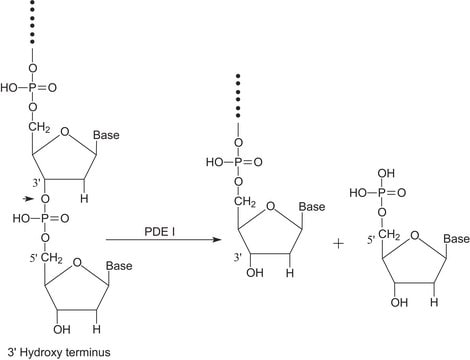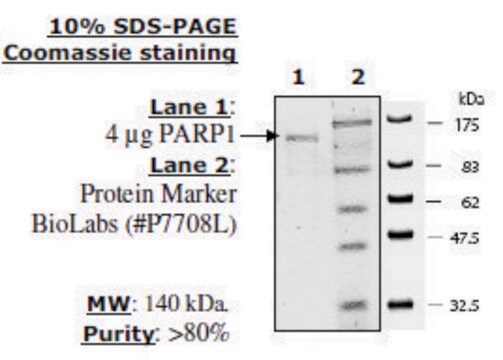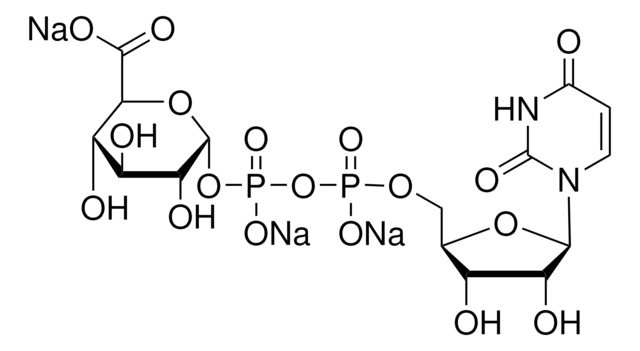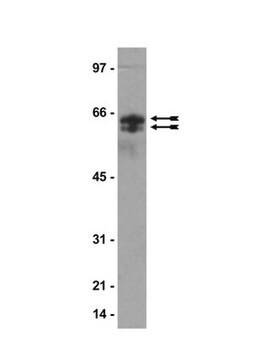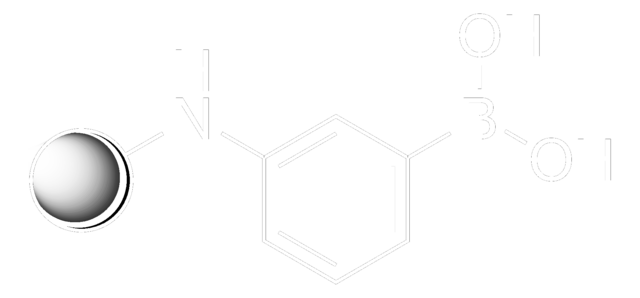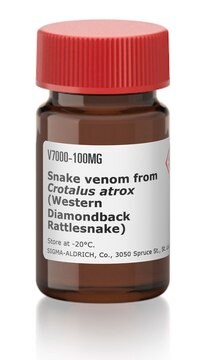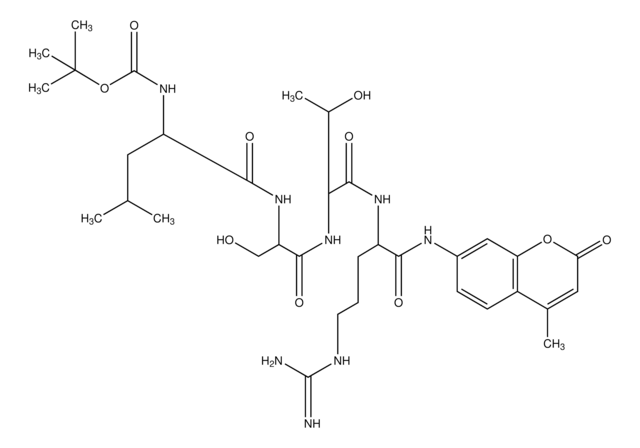SRP8023
PARG human
recombinant, expressed in Sf21 cells, His tagged, >95% (SDS-PAGE)
Sinônimo(s):
FNDC5 (cleaved), Poly(ADP-ribose) glycohydrolase
Faça loginpara ver os preços organizacionais e de contrato
About This Item
Produtos recomendados
fonte biológica
human
recombinante
expressed in Sf21 cells
etiqueta
His tagged
Ensaio
>95% (SDS-PAGE)
Formulário
liquid
peso molecular
~110 kDa by SDS-PAGE
embalagem
pkg of 2 μg
concentração
≥0.2 mg/mL
técnica(s)
cell based assay: suitable
cor
clear
solubilidade
water: soluble
nº de adesão UniProt
Condições de expedição
dry ice
temperatura de armazenamento
−70°C
Informações sobre genes
human ... PARG(8505)
Descrição geral
Research area: Cell signaling
Aplicação
PARG human has been used in the digestion of sciatic nerve sections, in co-immunoprecipitation, in in vitro glycohydrolase activity assay
Ações bioquímicas/fisiológicas
Poly(ADP-ribose) glycohydrolase(PARG) hydrolyzes poly(ADP-ribose) at glycosidic(1′′-2′′) linkage of ribose-ribose bond to produce free ADP-ribose. It is an endo- and exo-glycosidase. PARG plays arole in DNA repair and replication. Inhibited or depleted PARG in cells aremore prone to DNA-damaging agents. PARG also averts the accumulation of PAR inthe cytoplasm and parthanatos, a caspase-independent PAR-mediated type of celldeath.
forma física
Solution in 50 mM TRIS-HCl, pH 7.5, containing 100 mM sodium chloride, 0.2% NP-40, 50 mM imidazole and 10% glycerol.
Outras notas
Human PARG is fused to a His-tag.
Palavra indicadora
Danger
Frases de perigo
Declarações de precaução
Classificações de perigo
Repr. 1B
Código de classe de armazenamento
6.1D - Non-combustible acute toxic Cat.3 / toxic hazardous materials or hazardous materials causing chronic effects
Classe de risco de água (WGK)
WGK 1
Ponto de fulgor (°F)
Not applicable
Ponto de fulgor (°C)
Not applicable
Escolha uma das versões mais recentes:
Já possui este produto?
Encontre a documentação dos produtos que você adquiriu recentemente na biblioteca de documentos.
Sara C Larsen et al.
Cell reports, 24(9), 2493-2505 (2018-08-30)
ADP-ribosylation (ADPr) is a reversible posttranslational modification involved in a range of cellular processes. Here, we report system-wide identification of serine ADPr in human cells upon oxidative stress. High-resolution mass spectrometry and unrestricted data processing confirm that serine residues are
Jeannette Abplanalp et al.
Nature communications, 8(1), 2055-2055 (2017-12-14)
ADP-ribosylation is a posttranslational modification that exists in monomeric and polymeric forms. Whereas the writers (e.g. ARTD1/PARP1) and erasers (e.g. PARG, ARH3) of poly-ADP-ribosylation (PARylation) are relatively well described, the enzymes involved in mono-ADP-ribosylation (MARylation) have been less well investigated.
Sara C Buch-Larsen et al.
Cell reports, 32(12), 108176-108176 (2020-09-24)
ADP-ribosylation (ADPr) is a post-translational modification that plays pivotal roles in a wide range of cellular processes. Mass spectrometry (MS)-based analysis of ADPr under physiological conditions, without relying on genetic or chemical perturbation, has been hindered by technical limitations. Here
Xiao-Nan Zhang et al.
Nature communications, 10(1), 4196-4196 (2019-09-15)
Nicotinamide adenine dinucleotide (NAD+)-dependent ADP-ribosylation plays important roles in physiology and pathophysiology. It has been challenging to study this key type of enzymatic post-translational modification in particular for protein poly-ADP-ribosylation (PARylation). Here we explore chemical and chemoenzymatic synthesis of NAD+
Michelle Schacke et al.
International journal of molecular sciences, 20(3) (2019-01-30)
Poly- adenosine diphosphate (ADP)-ribose (PAR) is a polymer synthesized as a posttranslational modification by some poly (ADP-ribose) polymerases (PARPs), namely PARP-1, PARP-2, tankyrase-1, and tankyrase-2 (TNKS-1/2). PARP-1 is nuclear and has also been detected in extracellular vesicles. PARP-2 and TNKS-1/2
Nossa equipe de cientistas tem experiência em todas as áreas de pesquisa, incluindo Life Sciences, ciência de materiais, síntese química, cromatografia, química analítica e muitas outras.
Entre em contato com a assistência técnica